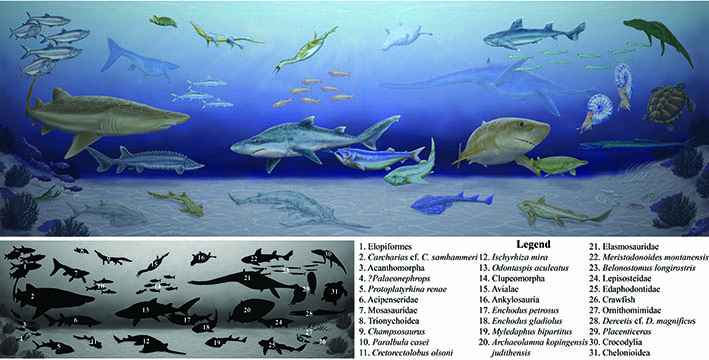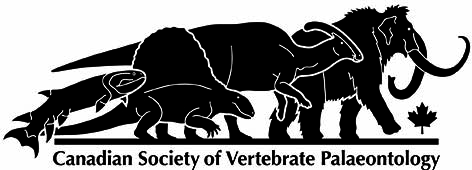Cranial osteology and reassessment of the historically collected South African gorgonopsians FMNH UC 1513 (Lycaenops cf. L. angusticeps) and AMNH FARB 5537 (Lycaenops angusticeps)
DOI:
https://doi.org/10.18435/vamp29406Keywords:
Synapsida, Therapsida, Gorgonopsia, Lycaenops, Late Permian, Karoo BasinAbstract
Lycaenops contains one of the most anatomically complete gorgonopsian specimens (AMNH
FARB 2240) known and is thought to represent one of the more taxonomically diverse forms, with several species historically attributed to it. Despite this, many species in this complex, aside from the type species, L. ornatus, are not well defined, requiring substantial revisions. At present, Lycaenops likely represents a ‘wastebasket taxon’, as an overly generic morphological grouping that includes any medium-sized gorgonopsians with a reduced postcanine series, long snout, slender skull arches, and moderate to minor cranial pachyostosis.
Here we provide a reassessment of the cranial osteology for two specimens previously assigned to Lycaenops including AMNH FARB 5537, the holotype of ‘L. angusticeps’, and FMNH UC 1513, the holotype of ‘Scymnognathus major’ that was later assigned to ‘L. cf. L. angusticeps’. Furthermore, FMNH UC 1513 has never been comprehensively assessed, with the original description being both brief and dated. Our anatomical and phylogenetic assessment of both specimens support their assignment to Lycaenops. We suggest that
‘L. angusticeps’ be regarded as a nomen dubium and refer FMNH UC 1513 to a yet to be described Lycaenops species pending a more comprehensive study of variation (e.g., differing proportions of the snout among other characteristics) within the genus.
Downloads
References
Bendel, E. M., Kammerer, C. F., Luo, Z. X., Smith, R. M., & Fröbisch, J. 2022. The earliest segmental sternum in a Permian synapsid and its implications for the evolution of mammalian locomotion and ventilation. Scientific Reports, 12(1), 13472
Bendel, E. M., Kammerer, C. F., Smith, R. M., & Fröbisch, J. 2023. The postcranial anatomy of Gorgonops torvus (Synapsida, Gorgonopsia) from the late Permian of South Africa. PeerJ, 11, e15378.
Broom, R. 1905. On the use of the term Anomodontia. Records of the Albany Museum, 1, 266-269.
Broom, R. 1913. On a nearly perfect skull of a new species of the Gorgonopsia. Annals of the South African Museum, 12, 8-10.
Broom R. 1925. On some carnivorous therapsids. Records of the Albany Museum. 25, 309-26.
Colbert, E. H. 1948. "The mammal-like reptile Lycaenops. Bulletin of the AMNH. 89 (6).
Gebauer, E.V.. 2007. Phylogeny and Evolution of the Gorgonopsia with a Special Reference to the Skull and Skeleton of GPIT/RE/7113 ('Aelurognathus?'parringtoni) (Doctoral dissertation, Universität Tübingen).
Kammerer, C.F. 2014. A redescription of Eriphostoma microdon Broom, 1911 (Therapsida, Gorgonopsia) from the Tapinocephalus Assemblage Zone of South Africa and a review of Middle Permian gorgonopsians. In Early evolutionary history of the Synapsida (pp. 171-184). Springer Netherlands.
Kammerer, C.F. 2015. Cranial osteology of Arctognathus curvimola, a short‐snouted gorgonopsian from the Late Permian of South Africa. Papers in Palaeontology.1(1):41-58.
Kammerer, C.F. 2016. Systematics of the Rubidgeinae (Therapsida: Gorgonopsia). PeerJ. 4, e1608.
Kammerer, C.F. 2017. Anatomy and relationships of the South African gorgonopsian Arctops (Therapsida, Theriodontia). Papers in Paleontology.
Kammerer, Christian & Masyutin, Vladimir. 2018. Gorgonopsian therapsids ( Nochnitsa gen. nov. and Viatkogorgon ) from the Permian Kotelnich locality of Russia. PeerJ. 6. e4954. 10.7717/peerj.4954.
Kammerer, C.F., Smith, R.M., Day, M.O. & Rubidge, B.S. 2015. New information on the morphology and stratigraphic range of the mid‐Permian gorgonopsian Eriphostoma microdon Broom, 1911. Papers in Palaeontology.1(2), 201-21.
Kammerer, C. F., Viglietti, P. A., Butler, E., & Botha, J. 2023. Rapid turnover of top predators in African terrestrial faunas around the Permian-Triassic mass extinction. Current Biology, 33(11), 2283-2290.
Kemp, T.S. 1969. On the functional morphology of the gorgonopsid skull. Philosophical Transactions of the Royal Society of London B: Biological Sciences. 256 (801), 1-83.
Krone, I. W., Kammerer, C. F., & Angielczyk, K. D. 2019. The many faces of synapsid cranial allometry. Paleobiology, 45(4), 531-545.
Liu, J., & Yang, W. 2022. A gorgonopsian from the Wutonggou Formation (Changhsingian,Permian) of Turpan Basin, Xinjiang, China. Palaeoworld, 31(3), 383-388
Lydekker, R. 1890. Catalogue of the fossil Reptilia and Amphibia in the British Museum (Natural history) Part IV. British Museum (Natural History). p. 111.
Mann, A., & Sidor, C.A. In press. Arctops umulunshi, n. sp., (Therapsida: Gorgonopsia) from the upper Madumabisa Mudstone Formation of Zambia, with new information on gorgonopsian postcranial anatomy.
Matamales-Andreu, R., Kammerer, C.F., Angielczyk, K.D. et al. 2024. Early–middle Permian Mediterranean gorgonopsian suggests an equatorial origin of therapsids. Nat Commun 15, 10346 . https://doi.org/10.1038/s41467-024-54425-5
Olson, E. C. 1937. The Cranial Morphology of a New Gorgonopsian. The Journal of Geology, 45(5), 511-527
Olson, E. C., & Broom, R. 1937. New Genera and Species of Tetrapods from the Karroo Beds of South Africa. Journal of Paleontology, 11(7), 613–619. http://www.jstor.org/stable/1298390
Osborn, H. F. 1903. The reptilian subclasses Diapsida and Synapsida and the early history of
the Diaptosauria. Memoirs of the American Museum of Natural History, 1, 449–507.
Ray, S., & Bandyopadhyay, S. 2003. Late Permian vertebrate community of the Pranhita–Godavari valley, India. Journal of Asian Earth Sciences. 21(6), 643-54.
Seely, H. G. 1894. Researches on the structure, organization andclassifiaction of the fossil Reptilia. Part IX., Section 1. On the Therosuchia. Philosophical Transactions of the Royal Sociaey of London B, 185, 987-1018
Sidor, C. A., & Mann, A. 2024. The sternum and interclavicle of Aelurognathus tigriceps (Broom & Haughton, 1913) (Therapsida: Gorgonopsia), with comments on sternal evolution in therapsids. Comptes Rendus Palevol, 23(6)
Sidor, C. A., Mann, A., & Angielczyk, K. D. 2023. Gorgonops and Endothiodon (Synapsida: Therapsida) from the Madumabida Mudstone Formation: ecidence of a previously unreported tetrapod biozone in the Mid-Zambezi Basin of southern Zambia. Journal of Vertebrate Paleontology, 43(1)
Sigogneau, D. 1970. RéVision SystéMatique Des Gorgonopsiens Sud-Africains. Paris: Éditions du Centre national de la recherche scientifique.
Sigogneau-Russell, D. 1989. "Theriodontia I". In H.-D., Sues (ed.). Encyclopedia of Paleoherpetology. Gustav-Fischer-Verlag. ISBN 978-3-89937-033-1.
Singh, S.A., Elsler, A., Stubbs, T.L. et al. 2024. Predatory synapsid ecomorphology signals growing dynamism of late Palaeozoic terrestrial ecosystems. Commun Biol 7, 201
Swofford, D.L. 2002. PAUP* Phylogeny Analysis Using Parsimony (* and other methods), version 40b10. Sinauer Association, Inc, Sunderland, Massachusetts.
Downloads
Additional Files
Published
How to Cite
Issue
Section
License
Copyright (c) 2025 Naiomi Cookson, Arjan Mann

This work is licensed under a Creative Commons Attribution 4.0 International License.
Submission of an article to Vertebrate Anatomy Morphology Palaeontology will be taken to mean that the article is an original work and not previously published or under consideration for publication elsewhere.
If the article is accepted for publication, it will be published on-line under Creative Commons Attribution 4.0 International (CC By 4.0) meaning:
Attribution — You must give appropriate credit, provide a link to the license, and indicate if changes were made. You may do so in any reasonable manner, but not in any way that suggests the licensor endorses you or your use.
No additional restrictions — You may not apply legal terms or technological measures that legally restrict others from doing anything the license permits.







